ISSN ONLINE(2278-8875) PRINT (2320-3765)
ISSN ONLINE(2278-8875) PRINT (2320-3765)
| F.C. Ezetoha, A.O. Nwokeke, L. C. Ohaneme and I.Onyemaobim Lecturer, Dept. of Computer Engineering Technology, Federal Polytechnic, Oko, Anambra State, Nigeria Correspondence author: F. C. Ezetoha |
| Related article at Pubmed, Scholar Google |
Visit for more related articles at International Journal of Advanced Research in Electrical, Electronics and Instrumentation Engineering
This paper is based on the study conducted in 2013 to assess the health hazards in substandard computer centres in Nigeria tertiary institution environment. The objective of this study was to investigate the extent of simultaneous occurance of computer vision syndrome, repititive strain injury, musculoskeletal disorder, stress, respiratory tract, skin problem and hearing disorder among workers in the substandard computer centres. The second objective was to investigate the association between duration of work per day and these health disorders. A total of 180 workers were involved in the study of whom 56.67% where females and 43.33% were males. The interviewed workers had been using computers and other machines for 2 and more hours a day and had worked in the cumputer centres for minimum of 4 years. Self administered questionaire was used as an instrument in this field survey study.The findings confirmed that computer vision syndrome, Repititive strain injury, musculoskeletal disorder, stress, hearing, respiratory tract, and skin problems occur simultaneously among workers in substandard computer centers. Workers who use computer daily for more than four hours in the computer centers are more likely subjected to the risks of all these seven health disorders. The Authors suggested some preventive measures and they urged the owners of these substandard computer centres, workers and the government of Nigeria and some other developing contries opts to adapt their practiability
Keywords |
| Substandard Computer Centres, Workers, Musculoskeletal Disorder, Computer Vision Syndrome, Repititive Strain Injury |
INTRODUCTION |
A. Background |
| The use computers to make money in small business centre/environment has been the order of the day in developing world. These computer centres have helped a lot in creating employment for computer literate youths. Majority of these centres are substandard. Some are built in form of kiosk without ceiling, whereas the larger ones are without good ventilation system. It was discovered that majority of these centres did not have standard desks and chairs, good computer sets and airconditioners for proper usage of computers. Figure 1a and 1b show two of the many types of the substandard computer centres. The computer centres especially the ones in Nigeria have problem of regular supply of public electricity and therefore depends mainly on their generators. These generators are kept and chained very close to the substandard computer centres because of thieves. Thus the workers and the computer users in the centres are subjected to different health risks. They sometimes complain of headache, fatigue, impaired hearing, vision problem, irritation, pains in some parth of the body, respiratory tract problems and musculoskeletal disorders. |
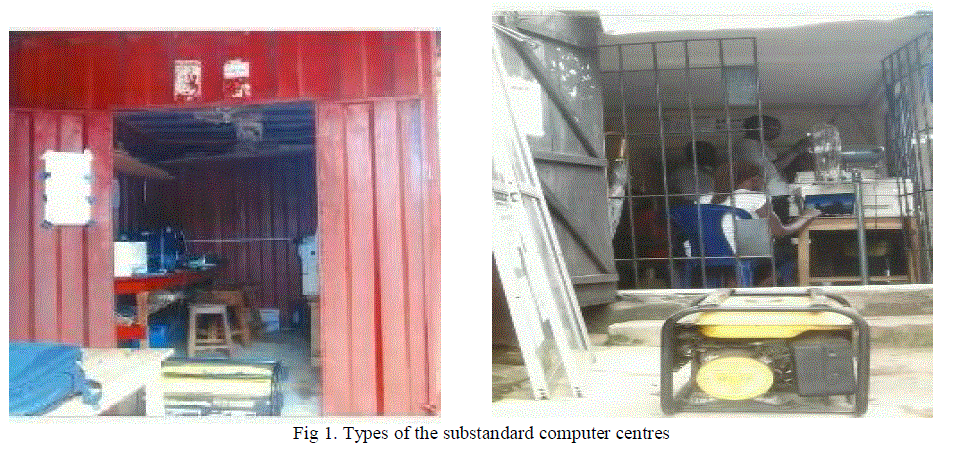 |
B. Risk factors for human health |
| The risk factors associated with prolonged use of computer in substandard computer centres are shown in table I. These factors are the source of the major health problems or injuries in the centres. Computing basics 2000 reveals that computer related health disorders cover a wide varity of health problems caused by or contributed by computer usage. The most common reported medical problems are computer vision syndrome, repititive strain injury (RSI), musculoskeletal disorder and stress [1]-[2]-[3]. Many researchers [4]-[5]-[6] consider computer vision syndrome as more frequently occurring health disorder among computer users. |
| The effects of uncomfortable environment such as poor air quality, noise, heat and other conditions contribute greatly to the health problem of workers of substandard computer centres. The generators used in the computer centres generate noise. Other sources of problems in the centres are from humans, and machines such as photocopiers, printers, fans and humans. Elevated sound levels such as the one in the substandard computer centre’s environment can cause hearing impairment, annoyance, sleep disturbance, hypertension, ischemic heart disease, vasoconstriction and other cardiovascular adverse effects [7]-[8]. |
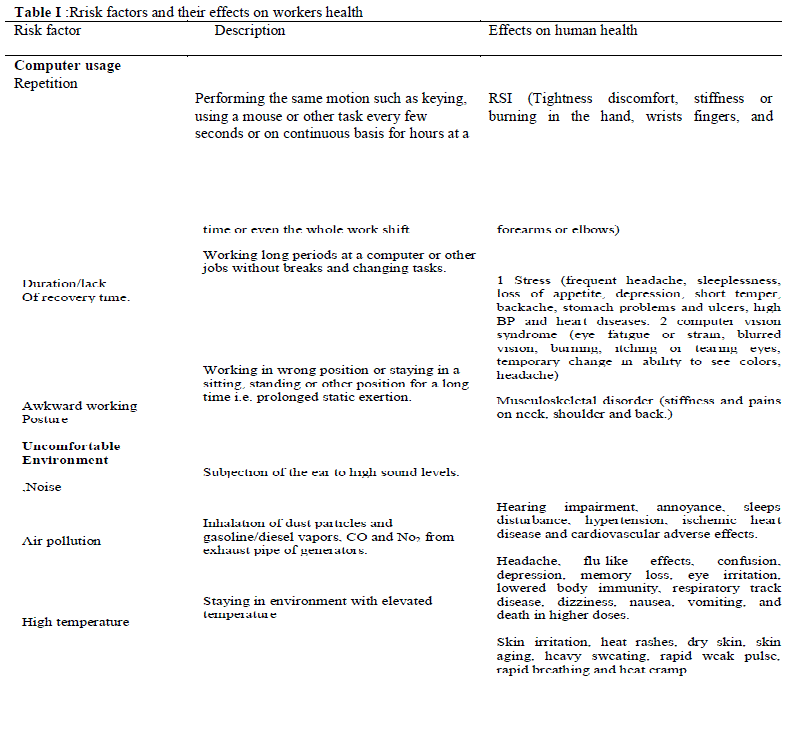 |
| In table 1; It shows the risk factors associated with prolonged use of computer in substandard computer centres and their effects on workers health. |
| Staying in environment with elevated temperature (higher than the room temperature) can cause skin irritation, heat rashes, dry skin, heavy sweating and fatigue. |
| Further, the gasoline and diesel used to run these generators give out carbon monoxide (CO), nitrogen oxides (NO2) and sulfur dioxide as waste products. Co as low a proportion as 0.5% (greater than 50% carboxyhemoglobin in the blood) by volume in the air can prove fatal within one hour, 0.05% produces headache after 10 hours, flu-like effects, confusion, depression and memory loss after more than 10 hours of exposure [9]. Larger exposures can affect central nervous system and heart and can even cause death. No2 react in the atmosphere with Hydrocarbons to form Ozone that irritate eye and respiratory track and thus can damage lung tissue, lowers body’s resistance to respiratory infections and worsen chronic lung disease such as asthma. Gasoline and diesel vapor inhaled while pouring them into the generator tanks can irritate the nose and throat, cause headache, dizziness, nausea, vomiting and confusion. In addition to the pollutants from the generators’ exhausted pipes, dusts from the environment are also inhaled by the workers and the clients. Dust particles can also affect the respiratory system of the body. The substandard computer centres environment, sometimes suffer elevated temperature (greater than room temperature) condition. The sources of the heat are generators, laptops and other machines, the position and nature of the computer centers structures. Long-term exposure to temperatures to temperatures higher than the room temperature can cause skin irritation, heat rashes, dry skin, heavy sweating, fatigue, rapid weak pulse, rapid breathing and heat cramp [10]. |
| Research has not been conducted in which both computer usage health disorders and environmental contributing health disorders are studied together. Therefore, to fill this gap, the present study by using field survey approach intends to investigate the prevalence of these diseases among substandard computer centre workers. The aim of the study is to find a relationship between extent of computer use in the substandard computer centres and computer vision syndrome, musculoskeletal disorder, RSI, stress, hearing, respiratory track, skin problems. The research questions are: |
| To what extent computer vision syndrome, musculoskeletal disorder, RSI, stress, hearing, respiratory track, and skin problems occur simultaneously among workers in substandard computer centres? Is there any relationship between extent of computer work in the substandard computer centres and computer vision syndrome, musculoskeletal disorder, RSI, stress, hearing, respiratory tract, skin problems? |
METHODOLOGY |
| The study adopted survey approach as primary data source for investigating the research problem. Self administered survey was used because it helps to generalize the result since the researchers cannot direct the state of respondents [11]. |
A. Sample |
| The investigation was limited to substandard computer centres workers in high institution environment. Federal Polytechnic, Oko (FPO), Anambra state, Nnamdi Azikiwe University (NAU), Anambra state, Federal University of technology, Owerri (FUTO), Imo state, Imo state University (IMSU), University of Nigeria, Nsukka (UNN), Enugu state and University of Lagos (UNILAG), Lagos state, environment were the high institution environment used for study. The sampling frame used was purposive sampling technique and it has the advantages of selecting the sample according to specific characteristics and situations [12]. Simple random sampling technique was used to choose the sample from the purposive sampling frame. The original sample size for this study was 240 but only 180 out of the 240 favorable responses were obtained. |
B. Data collection |
| Pre-designed self-administered questionnaire was used in data collection. In the questionnaire, demographic information about gender, age, and frequency of the computer user were requested. The workers were asked where and how they keep their noisy generators while working. They were further asked how they position their wrists and arms while typing, type and font size used. Eye position on the computer screen and the type of monitor used were also requested in the questionnaire. The questionnaire also asked questions on how often the body position is changed while working and the way the chair and desks supported legs while working. Finally, the respondents were asked to indicate all symptoms of diseases which they are experiencing. |
C. Data analysis |
| The data was analyzed using SPSS software vision 17. |
RESULTS |
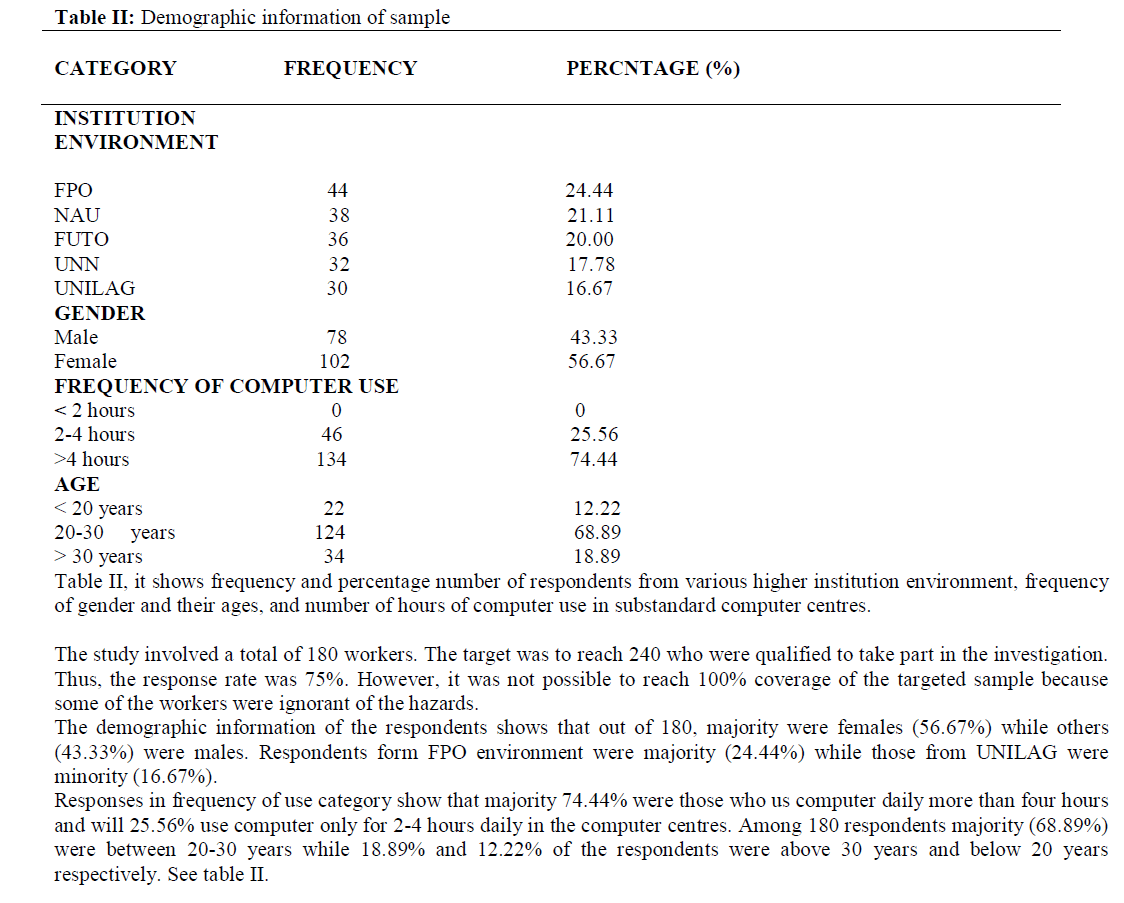 |
A. Health problems result |
| The frequency distribution of respondents who indicated the presence of stress, computer vision syndrome, hearing disorder, respiratory track problem, musculoskeletal disorder, repetitive strain injury (RSI), and skin problem are shown in figure 2 below. The results are based on the categories of diseases differentiated according to symptoms indicated by the respondents. The data clearly shows that majority of respondents (26%) are experiencing the entire health problems. Computer vision syndromes, hearing disorder, RSI, musculoskeletal disorder, respiratory track problem, stress and skin problem constitute 19%, 16%, 14%, 12%, 7%, 3% and 3% respectively. |
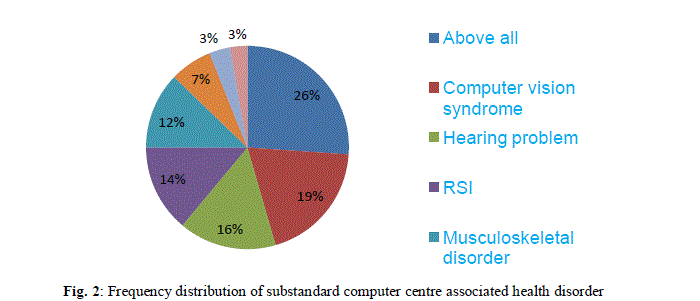 |
| Fig. 2, it shows the number in percent, of respondents who is aware of the different causes of substandard computer centre related health disorders. |
B. Causes of substandard computer centre associated health disorders |
| Frequency of the responses shows that 35% computer workers think that the problems are due to their use of computer. However there is considerable size of respondents (22%) who think that their health disorders are due to prolonged working in same posture. 22% of them believed that the health disorders are due to uncomfortable environment. 17% of the respondents are not aware of the actual reason of these problems. Only 4% think these are due to some other cause. See figure 3. |
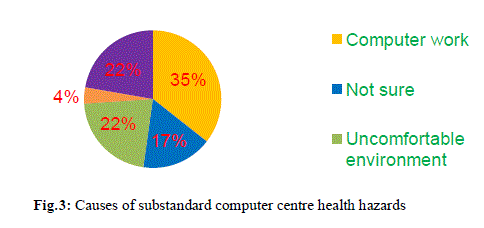 |
| In fig. 3, it shows the pie chart of the Causes of substandard computer centre health hazards. The number of respondents, who agreed that the cause is because of computer work or prolonged working in same posture or other causes and those not sure, is given as percentage of the total number of respondents. |
C. Association between frequency of computer use in substandard centers and health disorder |
| The association between frequency of computer use in substandard computer centers and health disorder is shown in the graph of figure 4. The line graph shows that workers who use computer more than four hours daily indicated symptoms of all four categories of computer related health disorders. Computer vision syndrome, hearing problem and respiratory problem show significant relationship with frequency of computer use. RSI, skin problem and musculoskeletal disorder show omparatively less significant relationship. Stress did not show a significant relationship with frequency of computer use. |
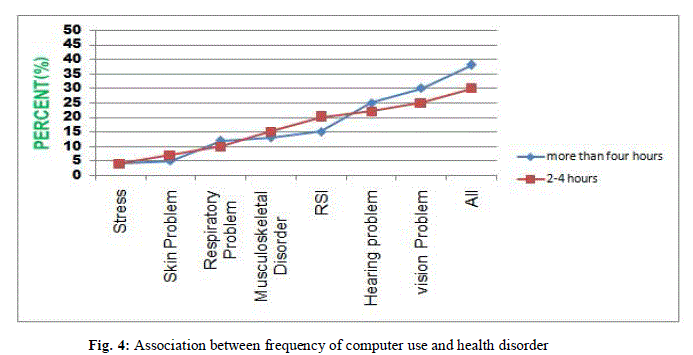 |
| In fig. 4, it shows the graphs of percentage number of respondents who indicated health disorders Vs number of hours of computer use in substandard centres. |
D. Gender and health disorder |
| The demographic information of respondents shows that 71.43% of females are affected by stress. Computer vision syndrome was 54.29% and musculoskeletal disorder 72.73%. RSI, hearing problem, respiratory problem and skin problems were 56.40%, 46.42%, 33.33%, and 59% respectively. However, among males 43.60% have RSI, 27.27% have musculoskeletal disorder, 45.71% have computer vision syndrome and only 28.57%have stress. |
| Hearing, respiratory and skin problem were 53.58%, 66.67% and 41% respectively. Majority of respondents who suffered all the health disorder were males (more than 56%) while that of females were more than 40%. See figure 5. |
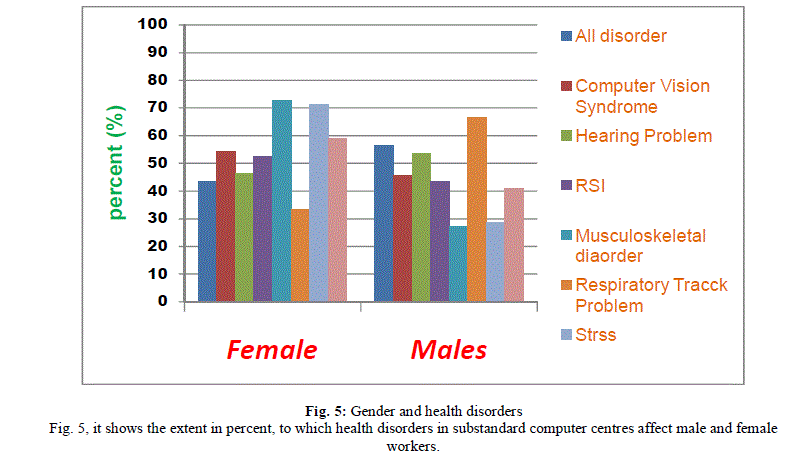 |
E. Age and health disorders |
| Respondents who are in age range of less than 20years suffer more of skin problem (about 50%) while they suffer less stress (14.29%). The respondents who are in age range of 20 to 30 years suffer more of musculoskeletal disorder (40.91%) and less skin problems (25%).Those who are in age range of above 30 years suffer more of stress (about 57.14%) and less musculoskeletal disorders (about 22%). The results are shown in table III. |
 |
 |
DISCUSSION |
| The study reached 75% of the targeted 240 workers. This can be taken as good return rate for any study sample to provide meaningful results reflecting the target environment. Gender-wise, females were the majority 56.67%.This is attributed to the female: male ratio at computer business centers were males are the minority. The frequency of computer use indicated that more workers work more than four hours daily (74.44%). This is because the business centres are opens around 8.0’clock in the morning and close officially by 7.00’clock in the evening. |
| The majority (68.89%) of workers were between 20 and 30 years old. This is attributed to the unemployment problem which mainly affects the youths of the age between 20 and 30 years. |
| The findings also show that female workers experienced computer centres related disorder more than male workers. This may be due to the female: male ratio in which females were higher and that they are less resistive to diseases. Research question one: To what extent computer vision syndrome, hearing problem, RSI, respiratory tract problem, musculoskeletal disorder, stress, and skin problem occur simultaneously among substandard computer centre workers? The study tried to identify the trends of health disorder related to working in the centres for prolonged time. The results confirmed the prevalence of all investigated health disorders among the workers. The presence of all disorders confirms the effects of all the risk factors stated in the table I above. A large number of respondents, who were not affected by all the health disorders, were confronted with computer vision syndrome or hearing disorder. Comparable number of respondents was affected by RSI and musculoskeletal disorder. Females were affected more because about four hours use of computer per day produces musculoskeletal disorder of neck or upper limb in women and six hours or more of computer use causes these symptoms in men [13]. Respiratory track problem and stress were also prevalent in the results. Skin problem was not reported in high frequency among the respondents but females were mostly affected. |
| The prevalence of all disorders among majority of substandard computer centers workers clearly shows that the simultaneous probability of these entire seven health disorder is high. |
| Research question 2: Is there any association between extent of computer use (hours per day) in substandard computer centre and computer vision syndrome, hearing problem, musculoskeletal disorder, respiratory tract problem, RSI, Stress, and skin problem? |
| The finding confirms that there is an association between frequency of computer use in substandard computer centres and prevalence of the entire health disorders. The workers who use computer daily for more than four hours are likely subjected to the risk of all these seven health disorders. On an individual basis the findings show that computer vision syndrome was found highest among those who use computer more than four hours daily. This result is true because surveys of computer workers reveal that vision-related problems are most frequently reported health related problems occurring in over 70% of computer workers [14]. The findings also show that musculoskeletal disorders and RSI were not very high among those who use computer more than four hours daily. This is because these two disorders are more related with awkward posture and not computer usage. |
| Majority of the respondents were aware of the causes of the health disorders. Minority (17%) was unaware of the causes of the health disorders. This result is particularly useful because it will encourage the substandard computer centre workers to seek preventive measures or make them to accept any safely measures introduced to computer users in the centres. |
| Hearing problem was also found to increase with the frequency of computer use in the computer centers. The workers who use computer daily for more than four hours are more exposed to noise. The researchers really reported that some of the workers could hardly hear them while trying to give out or collect the questionnaire in the evening time. The partial impaired hearing of some of the workers is due to prolonged exposure to daily noise. |
| The findings further show that respiratory track problem were high among those who use computer more than four hours daily. This is attributed to the fact that the air in the environments is polluted by the generator exhaust and dust particles as the day progresses. The findings finally show that skin problems were slightly increased with frequency of computer work. This is true because not all people are affected by skin problems due to elevated temperature. Sex, color, skin type and age are factors that determine whether the skin is to be affected. Female workers with soft skin, workers with light color and young workers are more likely affected by the heat stress. |
CONCLUSION |
| The outcomes of this study revealed simultaneously existence of health problems associated with the nature of work and habits of workers in the substandard computer centres. The study further revealed that there is an association between frequency of computer use in computer centres and prevalence of the entire health disorders. Previous studies revealed that computer vision syndrome, RSI, musculoskeletal disorder and stress can largely be attributed to improper use of computer devices like mouse, and keyboard, monitor, and lack of knowledge about safe computer usage practices and techniques. The situation is similar at the substandard computer centres except that the environment contributed to the observed health problems. All the substandard computer centers need to be made standard and all workers working in the centers needs training on how to avoid or minimize these health problems. Further, the government of Nigeria and those of the developing countries could adopt the preventive measures applied in U.K and USA on computer usage. |
RECOMMENDATIONS |
| The recommendations given here suggest the major areas that the workers in substandard computer business centres are supposed to abide to while discharging their duties. Creating awareness on the possible health risks associated with working in substandard computer centres and some preventive measures against them could reduce the risks. |
A. WORKSTATION |
Monitor |
| The monitor should be kept far enough (more than 20 inches from the eyes) and low enough for its top not to be above the horizontal line of sight for comfortable reading. The user should make sure that light sources are not reflected off the monitor’s screen by using flat screens setting the brightness and contrast control of the monitor. User should use appropriate font size on the screen. With these, the computer vision problems and musculoskeletal disorder of shoulder will be prevented. |
Keyboard and Mouse |
| It is recommended to keep wrist straight and in line with the forearms approximately parallel to the floor and using a slight touch on the keyboard. Keyboard and mouse should be placed close together at about the same height. The hand of the user should also be kept moving freely above the keyboard while typing. The user should use two hands rather than one while typing key combinations such as Ctrl, Shift or Alt. computer users should always avoid constant squeezing or griping of mouse. These recommended safety practices will reduce the occurrence of RSI disorders in the centres. |
Chairs |
| The chair should have backrest and be adjustable. This will allow placing feet firmly on the floor or a footrest and the hip flexed slightly. This will also allow the knees to be kept at 60-90 degree angle. The chairs should have backrest of about 6 to 9 inches high and at least 12 inches wide in the lumber region. The usage of the recommended backrest chairs will help in reducing musculoskeletal disorders and stress. |
B. PSYCHOSOCIAL BEHAVIORS |
| Computer users should take frequent short breaks (about 30 seconds’ breaks) every 10 to 20 minutes while keeping hands off the keyboard and letting arms drop at the side. They should often change sitting position every 15 minutes. They should try and do exercise during the breaks to loosen the shoulder and neck muscles. Those who keyboard up to 2 to 3 hours daily should take a break at least every 30 minutes. Computer users should reduce their workloads and work less than four hours on the computer daily. These measures will help reduce effect of musculoskeletal disorder, RSI and stress. |
C. ENVIRONMENTAL |
| Generator |
| The generators should be kept far away from the computer centres. The exhaust pipes of the generators should be placed high above 10 meters in order that the exhaust gases will pollute air above the roofs of the substandard computer centre building. We also recommend that the owners of the computer centres should make an arrangement to have a regular supply of public light. These safety measures will reduce the risk of CO, NO2, and gasoline/diesel vapor being inhaled by the workers. It will also reduce the noise level received by the workers. |
| Structure |
| The substandard computer centers buildings should be constructed in a way that they should have good ventilation, noise and heat proofs. Air conditioners should be installed in all computer centres. In order words, the centers should be made standard. With standard structure, furniture and devices, respiratory track, hearing and heat problems will be reduced. |
LIMITATIONS |
| The study has biasness of methods associated with survey research because it relied on the data collected through questionnaire. The study was conducted in the south-east and south-west part of Nigeria and did not cover other geopolitical zones. Health disorders such as tumors, cancers, skin cancer, wounds, cuts, dislocations, fractions of legs and arms caused by accidents, electrocution were not investigated in the study. The study also lacks true statistical assessment about the relation of the substandard computer centers health disorders. It is therefore recommended that a future research be conducted with rigorous methodologies which could involves using zung’s self rating depression scale and Hamilton’s depression rating scale measurement of depression, Snellen’s chart and Jaeger’s chart for accessing visual problems and other measuring tools for the disorders. |
References |
|